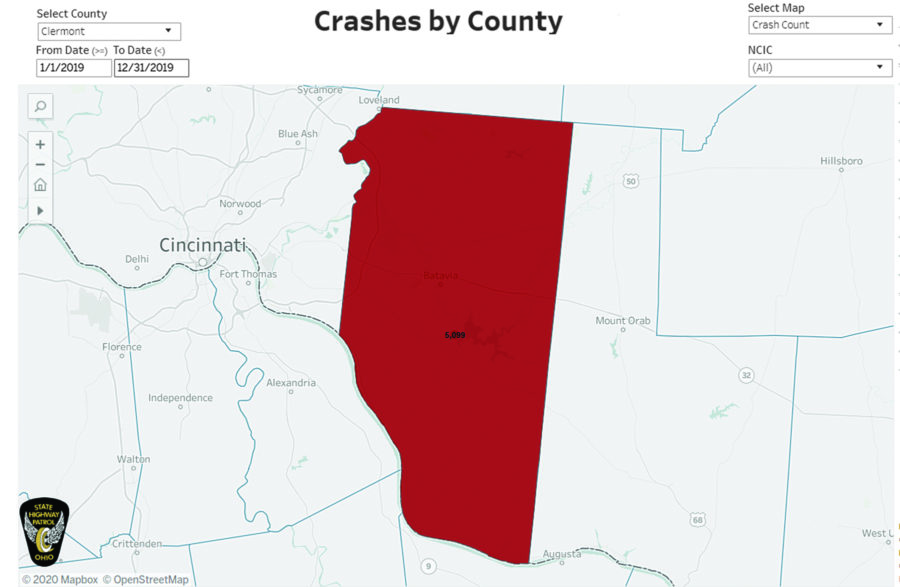
By Brett Milam
Editor
Nearly half of the 20 reported fatalities in 2019 came from motorcycle crashes, data from Clermont County Safe Communities and the Ohio State Highway Patrol shows. 
Motorcycle deaths have continued to climb the last number of years: in 2016, there were five fatalities; in 2017, two; in 2018, four; and in 2019, nine.
The Sun spoke with Jennifer Stewart-Hamblen, the program manager for the University of Cincinnati College of Medicine/Area Health Education Center and the CCSC, about the issue of motorcycle crashes and the data.
CCSC is funded by the United States Department of Transportation, the National Highway Traffic Safety Administration, and the Ohio Department of Public Safety, and administered via AHEC, located in Batavia, with the stated mission to save lives and reduce injuries on Ohio’s roads through leadership and partnering.
The Fatal Crash Review Committee, a sub-committee of CCSC, met in January to discuss the fatal crashes in the county for the last three months of 2019.
“While other factors also played a role in the occurrences of these crashes, the committee would like to remind everyone [of] the importance of two items: motorcycle safety gear and observation of surroundings,” Stewart-Hamblen said.
Of the nine motorcycle fatalities in the county for 2019, the majority weren’t wearing a helmet, and Stewart-Hamblen said, quite likely, they were new or inexperienced riders.
“While we promote the, ‘Look out for Motorcycles,’ message, since there are a high number of automobile drivers vs. motorcyclists, it is important that motorcycle riders are also informed,” she said.
In fact, Motorcycle Ohio offers training classes for new, returning, and experienced riders. For more information about those classes, visit http://bit.ly/39LEaJ1. Seats are currently available in Clermont County.
Motorcycle Ohio was established in 1988 and Great Oaks offers classes for basic rider skills, as well as basic returning rider skills.
Stewart-Hamblen said 80 percent of all nationwide reported motorcycle crashes result in injury or death; in 2017, there were 1,908 motorcyclist deaths attributable to not wearing a helmet.
“Helmets are estimated to be 37 percent effective at preventing fatalities. Also, nationwide 36 percent of motorcycle fatalities in 2017 were older adults (50-plus) returning to riding after a brief hiatus. Safety equipment and continued education are proven effective methods of motorcycle riding,” she said.
Being better educated and informed about the changes occurring is a positive step, Stewart-Hamblen said.
“Today’s roadways are not the same as 20, 10 or even five years ago. There are more drivers on the road and many more distractions within the vehicles from electronic mobile devices to vehicle electronic devices,” she said. “Plus the attitudes of drivers has changed. All of these factors have different ways to be addressed for an individual to be a safe, observant driver.”
Lt. Robert Hayslip with the Batavia Post of the Ohio Highway Patrol told The Sun via email that troopers will be focusing enforcement efforts on motorcycle-related violations, especially as the weather turns warm.
Hayslip said, even though it’s not a law that a rider must wear a helmet – unless they are a novice, meaning they’ve been riding for only one year – it “definitely decreases the chance of sustaining serious injury or death.”
“Many times the crashes are not the fault of the motorcycle operator, but there is simply very little protection on a motorcycle,” he said.
Additionally, Hayslip said there are several programs to obtain a motorcycle license/endorsement, such as Motorcycle Ohio. Hayslip said the program has been going on for 10 years, with the focus on learning the best practices for motorcycle operation.
For more information about basic rider skills or returning rider skills, go to http://bit.ly/2P5FhuY.
As it regards overall crash data, in 2019, there were 5,099 crashes. Of which, aside from age (which accounts for the lion’s share of variables causing crashes, with 1,891 mature-related incidents, 1,847 youth-related, and 959 teen-related), the highest variables are:
– Failure to yield (687).
– Unbelted (587).
– Speed (583).
– Deer (377).
– Distracted (277).
After that, it’s OVI (239), commercial (179), and alcohol (163).
There were 20 fatalities total, with 66 serious injuries, and 664 minor injuries, and an additional 476 possible injuries.
The worst months for crashes were November (546), and October (490).
Stewart-Hamblen said CCSC have yard signs and magnets available free with their traffic safety messages of “Look out for Motorcycles”; “Stay Alive: Don’t Text and Drive”; “Drive Sober or get Pulled Over” and “Click It or Ticket.”
CCSS presents those safety messages at public events and with programs throughout the county, including interactive messages, such as the goggles that simulate intoxication and impairment; the use of the board game, “Perfection,” to show it’s not possible to perform two tasks at once, such as reading and operating a vehicle; and using a race-car driven by an egg to show the importance of seat belts.
“We are willing to present to any group the interactive activities that we have as demonstrations,” she said.
Traffic safety is a concern for everyone that uses the roadway by any method, Stewart-Hamblen said, whether that’s cycling, driving or as a passenger.
“It is up to us to maintain the high level of safety within our immediate control – don’t drive impaired, even if it was “a little,”; don’t take the call or text while driving even if the light is red; don’t GPS that location while in motion; and take the second to buckle yourself and insist all others to also be secured — pets, too,” she said.
Every driver seems to think they are a “safe driver,” and yet, Stewart-Hamblen said, we have crashes and deaths.
For more information about CCSC, visit their Facebook page at DriveSober55 or call Stewart-Hamblen at 513-724-0276. Their website is med.uc.edu/AHEC/SafeCommunities.
